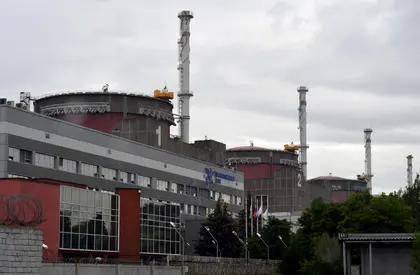The threat of an explosion at Europe’s largest nuclear power plant, Ukraine’s Zaporizhzhia NPP (ZNPP), has never been higher. If all six of its reactors are blown up, like what happened to just one reactor at Chornobyl in 1986, the territory up to the Iberian coast could be contaminated for the next 50 years, Oleksandr Kharchenko, director of the Energy Research Center, tells me by phone in Kyiv.
But such a nuclear catastrophe is hardly in Vladimir Putin’s plans. To understand the possible consequences of an accident at the ZNPP, we need to understand what the Russians want to achieve.
On June 22, President Volodymyr Zelenskyy issued an urgent statement that Ukrainian intelligence is aware of the planning of a “terrorist attack” at the Zaporizhzhia nuclear power plant – “a terrorist attack with a radiation release. They have prepared everything for this.”
This speech came immediately after the news of additional mining of the plant and the IAEA’s statement after Director General Rafael Grossi visited the plant. “The nuclear safety and security situation at the Zaporizhzhia Nuclear Power Plant is extremely fragile. The loss of the Kakhovka reservoir was a catastrophe for the region as a whole and has also added to the severe difficulties for this major nuclear power plant,” Grossi said according to the statement.
“Now more than ever, all sides must fully adhere to the IAEA’s basic principles designed to prevent a nuclear accident. We will intensify our efforts to help ensure nuclear safety and security, while also providing assistance to the affected region in other ways.”

Moscow Claims AFU’s Best Troops ‘Ground Down’, Kyiv’s 2025 War Plans ‘Derailed’
All of this is happening against the backdrop of intensified Russian propaganda in the southern regions, which explicitly mentions the beginning of July.
However, in these messages, Russian propagandists are trying to warn of an alleged provocation by Ukraine. Residents I keep in touch with in Kherson, my home region, already know that this may be a kind of warning about Russia’s own plans.
“If there is an accident beyond design that leads to a reactor meltdown, there will be a very significant increase in radiation, a huge amount of thousands of tons of highly radioactive materials, and if they are destroyed, there are no technical solutions in the world to solve it,” Kharchenko says, but adds that a nuclear accident can also be of a much smaller scale.
Five of the plant’s six reactors are in cold shutdown. This means that they are heating up inside themselves and almost not emitting anything to the outside, giving off minimal heat. This is an operating condition, but it is at a minimum level.
One reactor, which supplied heat to the city of Enerhodar and nearby settlements, is hot, but not fully operational. On a 10-point scale, its performance can be rated at about 4.
It is also reassuring to know that there is more than enough water in the cooling pools for at least two to three months, unless the pools’ locks are blown and the water is drained. And in the fall, the water level will be replenished with rainwater.
It still looks difficult to repeat the Chornobyl disaster, and the reactors themselves are already modernized and up to date. It is quite difficult to blow them up in the same way as happened in 1986.
Given these technical features, Kharchenko wants to believe that the Russians “are not trying to do this in the format of a nuclear disaster that will cover Europe but will do everything to deprive Ukraine of the opportunity to resume the work of the ZNPP after the de-occupation of the territories.”
A worse reason could be the Kremlin's desire to stop the Ukrainian counteroffensive and, in fact, retain the occupied territories for years. This would indeed require guaranteeing a certain level of radioactive release, which would severely harm life in southern Ukraine and most likely cover parts of Russia itself.
I do not believe that Putin cares about the people who will be affected, even the Russians themselves. And I don't believe that sanctions will stop him. The sanctions were a response to the biggest war and the biggest migration wave in Europe since the Second World War.
While these sanctions are extremely important, they did not stop these disasters. There is no control over the nuclear threat either.
Such a catastrophe could be politically beneficial to Putin. A nuclear disaster without the use of nuclear weapons. Russia can always say that the plant was shelled by the Ukrainian army, and international organizations will be investigating this for years. Russian propaganda can talk raise Putin's rating with news of “help” to the victims.
Now there are definitely explosives and weapons stored in the machine reactors of the ZNPP, and a huge area of the plant is mined. Ukrainians are increasingly believing in the real nuclear threat to ZNPP.
However, what actions the Kremlin will order and how they will be implemented by the not-so-competent Russian army remains a big question. Kharchenko says “it’s impossible to predict the actions of madmen.”
The views expressed are the author’s and not necessarily those of Kyiv Post.”
You can also highlight the text and press Ctrl + Enter






